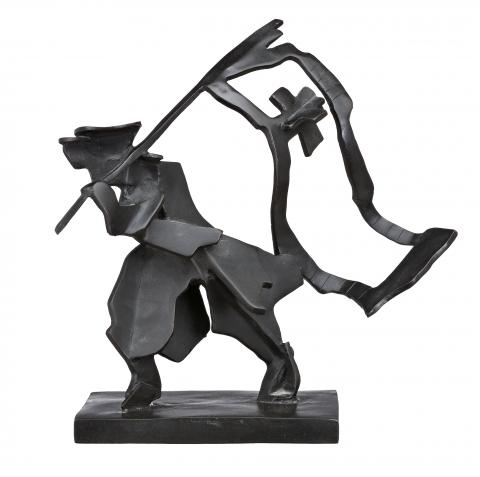MAN WITH FLAG, 2008
WILLIAM KENTRIDGE
bronze
27.0 x 16.5 x 13.0 cm
signed and numbered on base: W K 7/20
Annandale Galleries, Sydney
Private collection, Sydney
William Kentridge: The Nose, Annandale Galleries, Sydney, 6 July – 14 August 2010
These figures, Megaphone, Man with Flag and Man with Globe, 2008, create a motley crew of personified symbols, consumed and weighed down by their possessions, resolutely marching forwards. They appear simultaneously as activists and refugees, with a dual introspection and clear outlook on the world. Those familiar with William Kentridge’s work would know that the hybrid beings are not new. These, and many other characters populating the artist’s allegorical world, appear not only in his drawings and prints, but are also set in motion-animated films. Kentridge’s artistic practice is centered on the idea of transformation, his works constantly mutating in parallel with this line of inquiry. In this case, the sculptures were inspired by the Constructivist period in Russia between 1917 and 1928 and associated with Kentridge’s visual interpretation of Gogol’s short novel, The Nose and subsequent opera by Shostakovitch. William Kentridge was commissioned by the Metropolitan Opera, New York to direct the production (which premiered in 2010). The figures also appear together in a collaged procession, 1 Sketch for Construction for Return, 2008.
The personified megaphone first appeared in Kentridge’s work in 1990, in the film Monument. In a 1999 interview with international curator Carolyn Christov-Bakargiev, the artist explained its significance: ‘megaphones indicate what needs to be heard or seen, outside of oneself… they appear for example in photographs of Italian Futurist concertos for factory workers’.1 For Kentridge the theatrical playfulness of his works thinly veils a deep political commentary, seated in a recurring investigation of post-apartheid concerns in South Africa and nourished by a passion for avant-garde literature and theatre. The recurring motif of the procession is a particularly poignant device in Kentridge’s practice, a strong image of history and an ancient artistic technique for the creation of narrative.2
Straddling three-dimensional sculptural practice and two-dimensional trompe l’oeil strategies, these small bronzes are not merely static. When photographed, a certain point of view is fixed, presenting a specific scene. However, when observed in real life, and circumnavigated, they evolve in and out of, a coherent point of view. This deconstructive and vaguely absurdist approach bridges the gap with newer cinematic practices and shows a decidedly contemporary understanding of bronze sculpture.
Kentridge is a remarkably prolific artist, whose multidisciplinary body of work has reached international acclaim. Born of parents closely affiliated with the anti-apartheid movement, and grandson of a successful industrialist, Kentridge has a fraught personal history with South Africa, particularly with the maligned city of Johannesburg where he has lived and worked throughout his life.
1. Hecker, J.B., William Kentridge Trace: Prints from MoMA, Museum of Modern Art, New York, 2010, p. 60
2. Maltz-Leca, L., ‘Process/Procession: William Kentridge and the Process of Change’, The Art Bulletin, New York, vol. XCV, no. 1, March 2013, p. 139
LUCIE REEVES-SMITH
